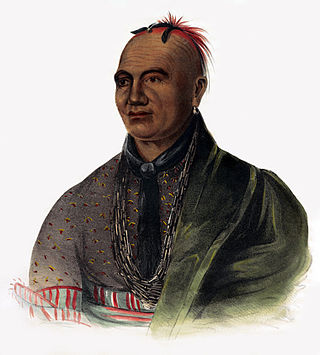
The Tuscarora are an Indigenous people of the Northeastern Woodlands in Canada and the United States. They are an Iroquoian Native American and First Nations people, based in New York and Ontario.

Hertford County is a county located in the U.S. state of North Carolina. As of the 2020 census, the population was 21,552. Its county seat is Winton. It is classified within the region known in the 21st century as the Inner Banks.

Gates County is a county located in the northeastern portion of the U.S. state of North Carolina, on the border with Virginia. As of the 2020 census, the population was 10,478, making it the fifth-least populous county in North Carolina. Its county seat is Gatesville. Gates County is included in the Virginia Beach-Chesapeake, VA-NC Combined Statistical Area. It is part of the Albemarle Sound area of the Inner Banks.

The Tuscarora War was fought in North Carolina from September 10, 1711, until February 11, 1715, between the Tuscarora people and their allies on one side and European American settlers, the Yamasee, and other allies on the other. This was considered the bloodiest colonial war in North Carolina. The Tuscarora signed a treaty with colonial officials in 1718 and settled on a reserved tract of land in Bertie County, North Carolina. The war incited further conflict on the part of the Tuscarora and led to changes in the slave trade of North and South Carolina.
The Waccamaw people were an Indigenous people of the Southeastern Woodlands, who lived in villages along the Waccamaw and Pee Dee rivers in North and South Carolina in the 18th century.

The Pamlico were Native Americans of North Carolina. They spoke an Algonquian language also known as Pamlico or Carolina Algonquian.
The Cape Fear Indians were a small, coastal tribe of Native Americans who lived on the Cape Fear River in North Carolina.

The Saponi are a Native American tribe historically based in the Piedmont of North Carolina and Virginia. They spoke a Siouan language, related to the languages of the Tutelo, Biloxi, and Ofo.

The Pedee people, also Pee Dee and Peedee, were a historic Native American tribe of the Southeastern United States. Historically, their population has been concentrated in the Piedmont of present-day South Carolina. It is believed that in the 17th and 18th centuries, English colonists named the Pee Dee River and the Pee Dee region of South Carolina for the tribe. Today four state-recognized tribes, one state-recognized group, and several unrecognized groups claim descent from the historic Pedee people. Presently none of these organizations are recognized by the Bureau of Indian Affairs, with the Catawba Indian Nation being the only federally recognized tribe within South Carolina.

Indigenous peoples of the Northeastern Woodlands include Native American tribes and First Nation bands residing in or originating from a cultural area encompassing the northeastern and Midwest United States and southeastern Canada. It is part of a broader grouping known as the Eastern Woodlands. The Northeastern Woodlands is divided into three major areas: the Coastal, Saint Lawrence Lowlands, and Great Lakes-Riverine zones.
The Coree were a very small Native American tribe, who once occupied a coastal area south of the Neuse River in southeastern North Carolina in the area now covered by Carteret and Craven counties. Early 20th-century scholars were unsure of what language they spoke, but the coastal areas were mostly populated by Iroquois and Algonquian peoples.
The Machapunga were a small Algonquian language–speaking Native American tribe from coastal northeastern North Carolina. They were part of the Secotan people. They were a group from the Powhatan Confederacy who migrated from present-day Virginia.

The Occaneechi are Indigenous peoples of the Northeastern Woodlands whose historical territory was in the Piedmont region of present-day North Carolina and Virginia.

The Cusabo were a group of American Indian tribes who lived along the coast of the Atlantic Ocean in what is now South Carolina, approximately between present-day Charleston and south to the Savannah River, at the time of European colonization. English colonists often referred to them as one of the Settlement Indians of South Carolina, tribes who "settled" among the colonists.
The Waxhaw people were a Native American tribe who historically lived in present-day counties of Lancaster, in South Carolina; and Union and Mecklenburg in North Carolina, around the area of present-day Charlotte.

The Nottoway are an Iroquoian Native American tribe in Virginia. The Nottoway spoke a Nottoway language in the Iroquoian language family.

The Chowanoc, also Chowanoke, are an Algonquian-speaking Native American tribe who historically lived near the Chowan River in North Carolina.
Francisco de Chicora was the baptismal name given to a Native American kidnapped in 1521, along with 70 others, from near Winyah Bay by Spanish explorer Francisco Gordillo and slave trader Pedro de Quexos, based in Santo Domingo and the first Europeans to reach the area. From analysis of the account by Peter Martyr, court chronicler, the ethnographer John R. Swanton believed that Chicora was from a Catawban group.
Woccon was one of two Catawban languages of what is now the Eastern United States. Together with the Western Siouan languages, they formed the Siouan language family. It is attested only in a vocabulary of 143 words, printed in a 1709 compilation by English colonist John Lawson of Carolina. The Woccon people that Lawson encountered have been considered by scholars to have been a late subdivision of the Waccamaw.

The Neusiok were an Indigenous people of the Southeastern Wooodlands in present-day North Carolina. They were also known as the Neuse Indians.











